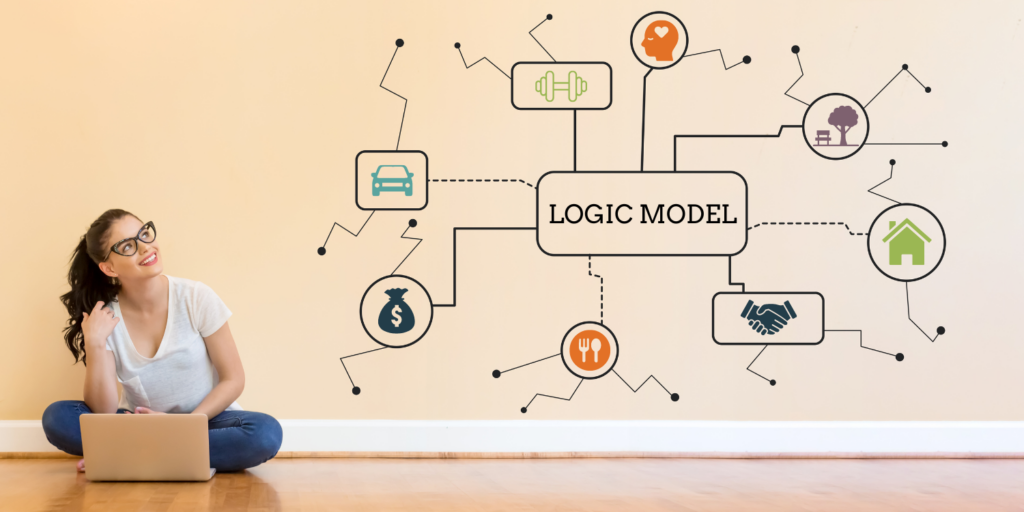In the complex world of program development and evaluation, logic models stand as critical tools for planning, implementing, and assessing initiatives designed to create change within communities or organizations. They offer a clear, visual representation of the mechanisms through which efforts are expected to lead to desired outcomes.
This comprehensive guide aims to provide a more in-depth understanding of logic models, surpassing the foundational knowledge to ensure your efforts are not only well-planned but also impactful and sustainable.
Table of Contents
What is a Logic Model? A Definition
A logic model is essentially a graphical depiction that outlines the sequence of actions thought to bring about a specific change. It operates on the underlying principle of cause and effect, visually mapping out the resources (inputs) required, the activities planned, and the expected results (outputs and outcomes), both short-term and long-term. By doing so, it articulates the rationale behind the strategy, offering a systematic approach to achieving goals.
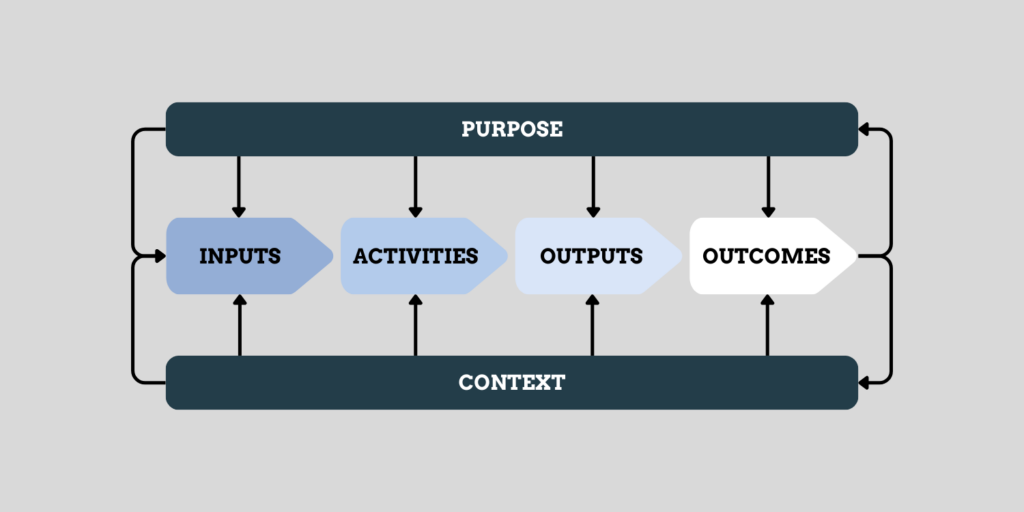
Key Components of a Logic Model
The key components of a logic model include:
- Inputs: These are the resources that you invest in your program. Inputs can include financial resources, human resources (such as staff and volunteers), materials, equipment, and technology, as well as partnerships and other supports. Inputs are what you use to carry out your program’s activities.
- Activities: Activities are the actions you take using the inputs. These can include workshops, training sessions, outreach efforts, and other interventions or strategies employed to address the identified problem or opportunity. Activities represent the work being done to produce certain outcomes.
- Outputs: Outputs are the direct products or services resulting from your activities. They are the tangible evidence that your activities have taken place. Examples of outputs include the number of workshops held, the number of participants attending a training session, publications produced, and services delivered.
- Outcomes: Outcomes are the changes or benefits that result from your program. Outcomes can be immediate, short-term changes; intermediate, medium-term changes; or long-term impacts. They can affect individuals, groups, communities, organizations, or systems. Outcomes are often categorized into:
- Short-term Outcomes: Changes in knowledge, attitudes, skills, or intentions.
- Intermediate Outcomes: Changes in behavior, practices, decision-making, policies, or social action.
- Long-term Outcomes: Broad, sustainable changes in conditions or status for individuals, groups, or communities.
- Context: These are the conditions or circumstances outside the program’s control that might affect its implementation and outcomes. External factors can include economic conditions, social trends, policy environments, and other community or environmental factors.
A well-constructed logic model visually represents the theory of change underlying a program, showing how planned work leads to desired outcomes. It serves as a valuable planning, implementation, evaluation, and communication tool, ensuring all stakeholders have a shared understanding of the program’s goals and methods.
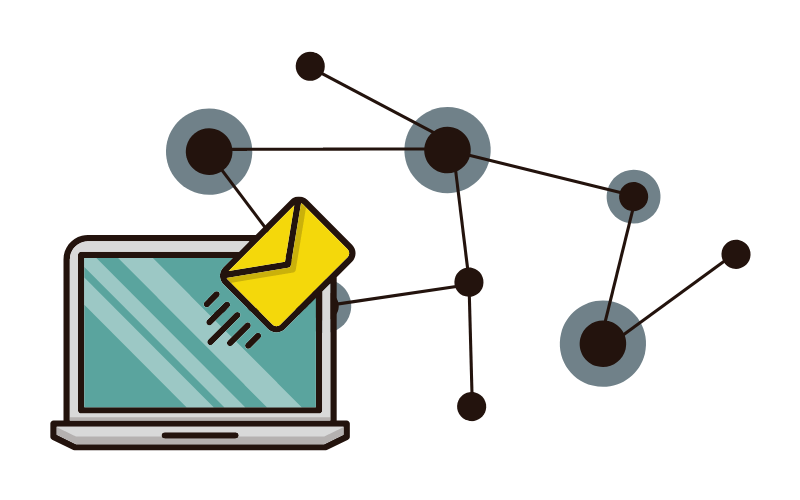
Get our monthly newsletter with resources for cross-sector collaboration, VNL recommended reading, and upcoming opportunities for engaged in the “network way of working.”
Logic Models vs. Theories of Change
Logic models and theories of change are closely related concepts used in program planning and evaluation, sharing similarities and differences in their structure and purposes:
Similarities
- Foundation for Planning and Evaluation: Both are used to design, implement, and evaluate programs or interventions, providing a structured approach to understand how initiatives are expected to work.
- Visualization of Relationships: They both visually map out the relationship between program inputs (resources), activities, outputs, outcomes, and intended impact, offering a graphical representation that helps stakeholders understand the program’s goals and mechanisms.
- Assumption Highlighting: Logic models and theories of change require identifying assumptions about how and why change is expected to occur as a result of program activities, helping to clarify the underlying rationale of the program.
Differences
This table shows the differences between logic models and theories of change in terms of their focus and detail, purpose and use, and complexity and flexibility.
| Aspect | Logic Model | Theory of Change |
| Focus and Detail | Focuses on operational aspects, outlining activities, outputs, and outcomes. Linear and simplistic, highlighting the flow from inputs to impact. | Provides a detailed explanation of how and why change is expected to happen. Explores causal pathways and includes detailed assumptions. |
| Purpose and Use | Serves as a management and planning tool for developing, implementing, and evaluating programs. Used for communicating program structure and monitoring progress. | Used for strategic planning and evaluation, understanding broader impacts and the complex system of program operation. Useful for systemic or complex changes. |
| Complexity and Flexibility | More straightforward and static, focusing on short-term achievements. | More dynamic and flexible, accommodating complex interventions and multiple pathways to change. Adapts to new insights and changes in context. |
Utility of Logic Models
Logic models are used in a variety of ways depending on your problem and stage of planning to provide insight and direction. Here are three examples:
- Strategic Planning: Logic models facilitate strategic planning by ensuring all activities are aligned with the overall mission and intended impacts. They help identify gaps in logic where activities may not lead to the desired outcomes.
- Effective Communication: They serve as a common language, making the proposed initiative understandable to stakeholders, funders, and team members, enhancing collaboration and support.
- Monitoring and Evaluation: By clearly outlining expected outcomes, logic models provide a framework for monitoring progress and evaluating the effectiveness of initiatives, guiding necessary adjustments.

How to Develop a Logic Model
Developing a logic model is a strategic process essential for planning, implementing, and evaluating projects or programs. This comprehensive approach facilitates a clearer understanding of your initiative’s flow and impact. Here are more detailed steps and insights for creating a robust logic model:
1. Identify the Problem or Opportunity:
Begin by clearly articulating the issue your initiative aims to address or the opportunity it seeks to capitalize on. This sets the stage for the entire model.
- Research and Analysis: Before defining the problem or opportunity, conduct thorough research. Understand the context, the stakeholders involved, and the existing gaps or opportunities. Utilize data and evidence to support your identification.
- Stakeholder Engagement: Involve key stakeholders in this early stage to ensure a comprehensive understanding of the issue from multiple perspectives. This inclusivity enhances the model’s relevance and effectiveness.
2. Define Inputs:
Inputs are the resources needed for your program’s execution, including time, money, personnel, and other assets. Clearly identifying inputs helps in understanding the scope and scale of the initiative.
- Comprehensive Resource Assessment: Beyond identifying basic resources like time and money, consider the value of partnerships, community support, existing infrastructure, and intellectual property. This broader view can reveal additional assets or potential gaps.
- Resource Allocation Strategy: Plan how these inputs will be acquired and allocated. This strategy should be realistic and consider potential challenges in resource availability.

Get our monthly newsletter with resources for cross-sector collaboration, VNL recommended reading, and upcoming opportunities for engaged in the “network way of working.”
3. Outline Activities:
Activities are the actions or processes undertaken to use the inputs effectively. They should directly relate to addressing the identified problem or opportunity.
- Activity Planning: Develop a detailed plan of the actions needed to utilize inputs effectively. Each activity should be actionable, measurable, and directly tied to addressing the identified problem or opportunity.
- Timeline and Sequence: Establish a timeline for these activities, considering the logical sequence and dependencies between actions. This planning helps in setting realistic milestones and deadlines.
4. Specify Outputs:
Outputs are the direct results of your activities, often quantifiable. They are the immediate evidence that your activities have been executed.
- Quantifiable Metrics: Ensure outputs are measurable. Define clear metrics that will be used to track the progress and success of each activity.
- Expectation Management: Clearly outline what is achievable within the scope of the resources and time available. This clarity helps manage stakeholders’ expectations and supports future evaluations.
5. Articulate Outcomes:
Outcomes are the short-term and long-term effects of your initiative, indicating the change or impact resulting from your activities. Distinguishing between immediate, intermediate, and ultimate outcomes clarifies the pathway of change.
- Short-term and Long-term Impact: Distinguish between immediate impacts (short-term outcomes) and the broader changes (long-term outcomes) you aim to achieve. This distinction helps in setting realistic goals and in the evaluation of the program’s effectiveness over time.
- Outcome Indicators: Identify indicators for each outcome that can measure the change. These indicators should be specific, measurable, attainable, relevant, and time-bound (SMART).
6. Use Appropriate Detail Level:
The complexity of your logic model should match its intended use. For internal planning, more detail may be beneficial, while communication with external stakeholders might require a simplified version.
- Audience Consideration: Tailor the complexity of your logic model to your audience. A detailed model may be necessary for internal team members and funders, while a simplified version could be more suitable for the general public or external stakeholders.
- Flexibility: While it’s important to be detailed, ensure your model is flexible enough to adapt to changes or new insights without becoming overly complicated or rigid.
7. Iterate and Refine:
Developing a logic model is an iterative process. Stakeholder feedback and real-world testing will often necessitate adjustments.
- Feedback Loops: Create mechanisms for regular feedback from stakeholders and participants. This feedback is crucial for identifying areas of improvement.
- Continuous Improvement: Treat your logic model as a living document. Regularly review and update it to reflect new insights, changes in context, or shifts in strategy. This iterative process ensures the model remains relevant and effective.
Additional Tips and Insights:
- Visual Representation: Use diagrams or flowcharts to visually represent the relationships between inputs, activities, outputs, and outcomes. Visual tools can make the logic model more accessible and understandable.
- Alignment with Goals: Ensure that every component of your logic model aligns with the overarching goals and objectives of your initiative. This alignment guarantees that your efforts are focused and effective.
- Evidence-Based: Wherever possible, base your logic model on evidence and best practices. This approach increases the likelihood of success and credibility among stakeholders.
Developing a logic model with these detailed steps and insights will enhance the planning, implementation, and evaluation of your project or program. It serves as a roadmap, guiding your initiative from conception to impact, ensuring that every step is purposeful and aligned with your ultimate goals.
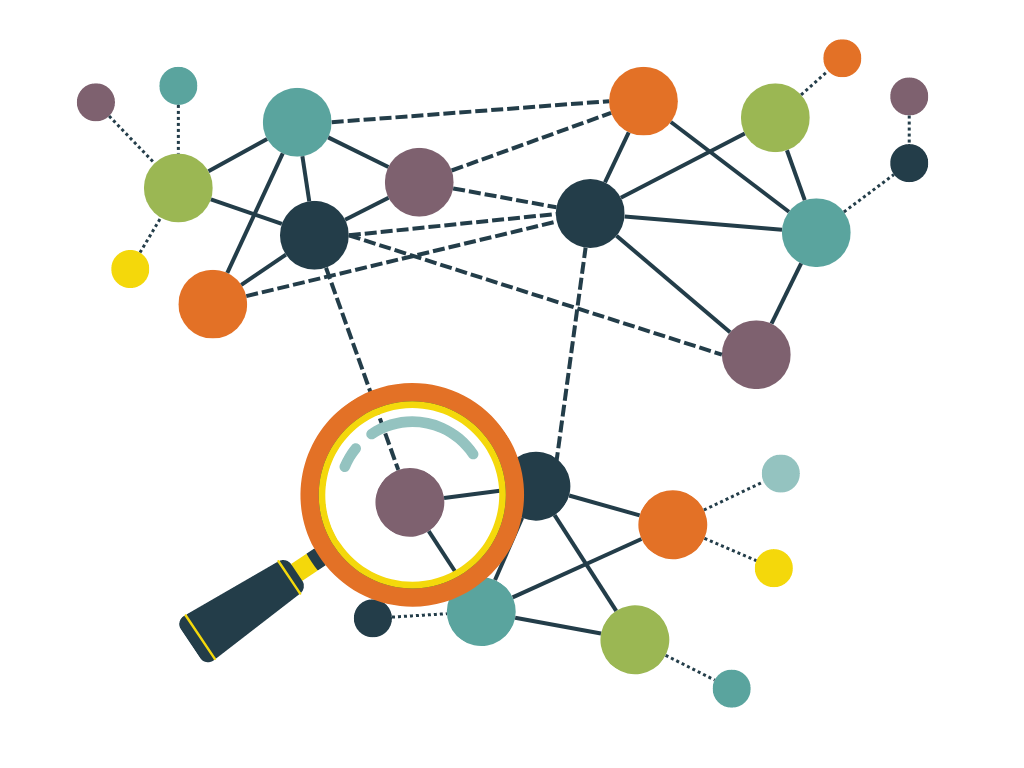
Logic Model Examples
Here are a few examples of what a simple logic model might look like in a few different types of community-based programs.
- Public Health Campaigns: A smoking cessation program.
- Inputs: Funding from health organizations, trained staff, educational materials.
- Activities: Workshops, support groups, advertising campaigns.
- Outputs: Number of workshops held, participants in support groups, reach of advertising.
- Outcomes: Increase in community awareness about the dangers of smoking, reduction in smoking rates, improvement in public health.
- Educational Initiatives: An after-school program for at-risk youth.
- Inputs: Funding from local government and donations, school facilities, teachers, and volunteers.
- Activities: Tutoring, mentoring, extracurricular clubs, and sports.
- Outputs: Hours of tutoring provided, number of students participating.
- Outcomes: Improved academic performance, increased school attendance rates, reduction in juvenile delinquency.
- Community Development Projects: A neighborhood revitalization project.
- Inputs: Grants, local businesses’ support, community members’ time.
- Activities: Renovation of public spaces, establishment of community gardens, organization of local markets.
- Outputs: Number of renovated spaces, gardens created, markets held.
- Outcomes: Enhanced community cohesion, increased local economic activity, improved quality of life for residents.
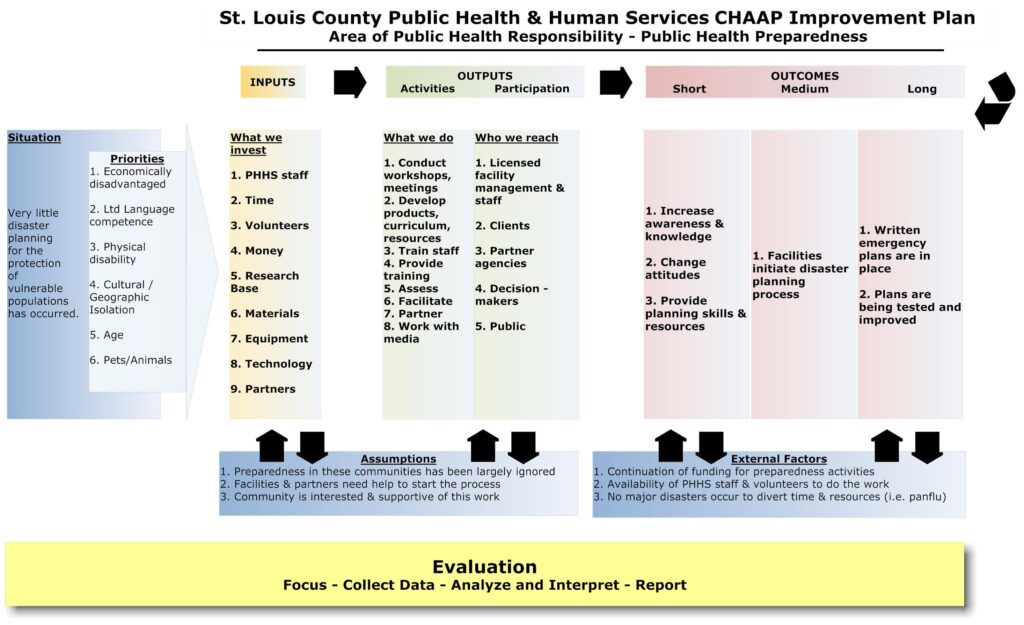
Enhancing Logic Model Effectiveness
Not all logic models are the same. Depending on how you approach the process, who you include, and how much you take into account the environment and context, your logic model effectiveness may vary considerably. These are some best practices and tips to enhance the usefulness of your logic model.
- Engagement and Collaboration: Involving a diverse group of stakeholders in the development process ensures a comprehensive understanding of the problem and enriches the model with multiple perspectives.
- Research and Evidence Integration: Ground your logic model in research and evidence, incorporating proven strategies and acknowledging areas of uncertainty that require innovative approaches.
- Sensitivity to Context: Tailor your model to the specific context in which the initiative will operate, considering cultural, economic, and environmental factors that might influence outcomes.
- Flexibility: While a logic model provides a roadmap, it should not be so rigid that it cannot accommodate changes based on emerging insights or shifting conditions.
Benefits and Limitations of Logic Modeling
Logic models have important benefits for community programs, but also have limitations to be aware of during your planning processes.
- Benefits:
- Enhances strategic coherence by linking activities to outcomes.
- Facilitates effective communication among stakeholders.
- Provides a framework for monitoring progress and evaluating impact.
- Supports adaptive management by identifying what is working and what is not.
- Limitations:
- Risk of oversimplification, potentially overlooking complex interactions and external influences.
- Development can be time-consuming and may require expertise not readily available.
- Models are based on assumptions that may not hold true in all contexts, necessitating regular review and adaptation.
Different Ways to Use Your Logic Model
A logic model serves as a comprehensive framework for program development, implementation, and evaluation by visually depicting the relationships between program resources, activities, and anticipated outcomes. Here’s how it can be effectively used across various stages of a program:
1. Program Development
- Clarify Purpose and Scope: A logic model helps in clearly defining the program’s objectives, ensuring all stakeholders have a unified understanding of its purpose and scope.
- Identify Resources and Needs: It outlines the inputs or resources required for the program, such as funding, staff, and materials, enabling planners to identify what they need to start and sustain the program.
2. Program Implementation
- Guide Implementation: It acts as a roadmap, guiding the implementation process and helping managers ensure that the program’s activities are conducted as planned.
- Monitor Progress: As activities are implemented, the logic model can be used to monitor progress and make adjustments as necessary, ensuring the program remains on track towards achieving its goals.
3. Program Evaluation
- Set Evaluation Criteria: The model sets clear criteria for what success looks like at various stages (outputs, outcomes, and impact), making it easier to measure and assess program effectiveness.
- Identify Evaluation Points: It helps identify critical points for evaluation, enabling the collection of relevant data on program performance and outcomes.
Importance of Logic Models in Collaborative Efforts
Cross-sector collaboration involves partnerships between organizations from different sectors (public, private, and nonprofit) to address complex social issues that no single entity can tackle alone.
These collaborations, often taking the form of community partnerships, networks, or coalitions, aim to leverage diverse resources, expertise, and perspectives to achieve shared goals. Logic models in this context play a crucial role in aligning the efforts of diverse stakeholders towards common objectives, ensuring clarity and coherence in collective action.
Social Network Analysis (SNA) in Logic Model Development

Social Network Analysis (SNA) offers powerful tools and methodologies for understanding and visualizing the relationships and flows between different entities within a network. When integrated with logic model development, SNA can significantly enhance the design and effectiveness of network interventions in several ways:
- Identifying Key Actors and Relationships: SNA can help identify central organizations or individuals in a network who can play pivotal roles in disseminating information, mobilizing resources, or bridging disconnected groups. This information can inform the logic model by highlighting where targeted efforts or interventions could yield the most significant impact.
- Mapping Resource Flows: By analyzing the flow of resources (information, funding, support) within the network, SNA can reveal gaps or bottlenecks that might hinder the achievement of desired outcomes. Incorporating these insights into the logic model can lead to more targeted and efficient resource allocation.
- Assessing Network Health: SNA metrics can provide insights into the health and effectiveness of the collaboration, such as the degree of connectivity, trust, and reciprocity among partners. This information can inform strategies to strengthen the network, which can be reflected in the activities and outputs of the logic model.
- Evaluating Impact: SNA can also support the evaluation component of the logic model by measuring changes in the network structure and relationships as a result of the intervention, providing a more nuanced understanding of impact beyond traditional outcome metrics.
PARTNER CPRM: A Tool for Developing Collaborative Logic Models
PARTNER CPRM, grounded in network science, is particularly well-suited for informing the development of logic models for community networks and collaborations. By providing a user-friendly platform for conducting SNA, PARTNER helps organizations:
- Visualize their Network: Organizations can map their network, identifying key partners, the strength of relationships, and potential areas for growth or reinforcement.
- Measure and Track Changes: The tool allows networks to measure and track changes over time, providing empirical data to inform the logic model’s development and adjustment.
- Facilitate Collaborative Planning: PARTNER’s visualizations and metrics can be shared among stakeholders to facilitate discussions around strategic planning, role clarification, and collective goal setting, which are critical components of a comprehensive logic model
Want to learn more? Request a personalized web demo to see the platform yourself and ask questions from a network science expert.
FAQ: Logic Model
Here are some frequently asked questions related to logic models and their use for program development, implementation, and evaluation.
If your question isn’t addressed below, leave a comment, and we will get back to you with an answer and more information as soon as possible.
Q: What is a logic model?
A: A logic model is a systematic and visual way to present and share your understanding of the relationships among the resources you have to operate your program, the activities you plan, and the changes or outcomes you hope to achieve. It outlines the sequence of actions expected to bring about a specific social change through a series of cause-and-effect links.
Q: What are the 5 main components of a logic model?
A: The 5 main components of a logic model include:
- Inputs: The resources, contributions, and investments that go into the program.
- Activities: What the program does with the inputs to fulfill its mission.
- Outputs: The direct products of program activities.
- Outcomes: The specific benefits or changes for participants or the target population during and after the program.
- Impact: The broader or long-term effects of the program.
Q: What are some different types of logic models?
A: Different types of logic models include:
- Theory-based models: Focus on the theoretical framework underpinning the program.
- Outcome-based models: Emphasize the outcomes or changes expected from the program.
- Activities-based models: Detail the activities or interventions the program will undertake.
- Contextual models: Incorporate environmental or contextual factors that influence the program.
- Process-based models: Focus on the processes through which programs lead to outcomes, highlighting the sequence of events and interactions that occur.
Q: How do you create a logic model?
A: Creating a logic model involves several steps:
- Define the problem your program is addressing.
- Identify your program’s inputs, or resources.
- Outline the activities or interventions your program will undertake.
- Specify the outputs or direct products of your activities.
- Detail the short-term, intermediate, and long-term outcomes you expect to achieve.
- Review and refine your model through stakeholder engagement and feedback.
Q: What is the difference between a logic model and a theory of change?
A: A logic model is a tool used to conceptualize your program’s operation, from inputs to outcomes. It focuses more on the activities and the expected outcomes. A theory of change is broader, explaining not only what will happen but why it will happen, detailing the assumptions and contextual factors that underpin the expected change process.
Q: What is the purpose of a logic model?
A: The purpose of a logic model is to provide a clear, visual explanation of how your program is intended to work. It helps stakeholders understand the program’s goals, how it will achieve them, and how success will be measured. Logic models are useful for planning, implementation, evaluation, and communication about the program.
Q: What are inputs in a logic model?
A: Inputs in a logic model are the resources, such as time, money, personnel, equipment, and information, that you invest in your program to carry out your activities and achieve your desired outcomes.
Q: Are logic models still used?
A: Yes, logic models are widely used in program planning, implementation, and evaluation across various fields, including public health, education, and nonprofit program management. They remain valuable tools for articulating program logic, ensuring alignment among activities and outcomes, and communicating program impact to stakeholders and funders.
Q: What are the key limitations for a logic model?
A: Key limitations of logic models include the potential for oversimplification of complex processes, the assumption of linear causality which may not capture all program dynamics, and the challenge of accurately depicting the program’s context and external factors.
Q: What software is used to make logic models?
A: Several software options can be used to create logic models, including Microsoft Word and PowerPoint for basic diagrams, as well as more specialized tools like Lucidchart, Canva, and Visio that offer more advanced diagramming and design features tailored for creating comprehensive logic models.
Q: When should you do a logic model?
A: A logic model should be developed at the planning stage of a program to clarify its structure and intended effects. It can also be useful for existing programs undergoing review or redesign, as it helps stakeholders understand and agree on the program’s objectives, strategies, and measures of success.
Conclusion: What Is a Logic Model?
A well-constructed logic model is an indispensable tool for anyone looking to design, implement, or evaluate a program or initiative. By providing a clear roadmap from inputs to outcomes, it not only facilitates planning and execution but also enhances the ability to communicate the initiative’s value proposition to stakeholders and funders.
While developing a comprehensive logic model requires effort and collaboration, the clarity and direction it offers make it a worthwhile investment in achieving meaningful and sustainable impact.
Additional Resources:
Here are some additional websites, resources, and articles related to logic models.
- Program Evaluation Framework Checklist: Logic Models | Centers for Disease Control and Prevention
- Developing a Logic Model or Theory of Change | Community Took Box
- Logic Modeling is a Way of Thinking | University of Wisconsin-Madison
- The Logic Model As a Tool for Developing A Network Performance Measurement System
- How to Develop a Logic Model – How-To-Guide | Compass
- 19 Fillable Logic Model Templates & Examples
- Free Canva Template: Logic Model | Eval Academy

Alex is Director of Marketing & Communications at Visible Network Labs. His interests include public policy, environmental conservation, and the intersection of grassroots advocacy and digital communication strategies.
